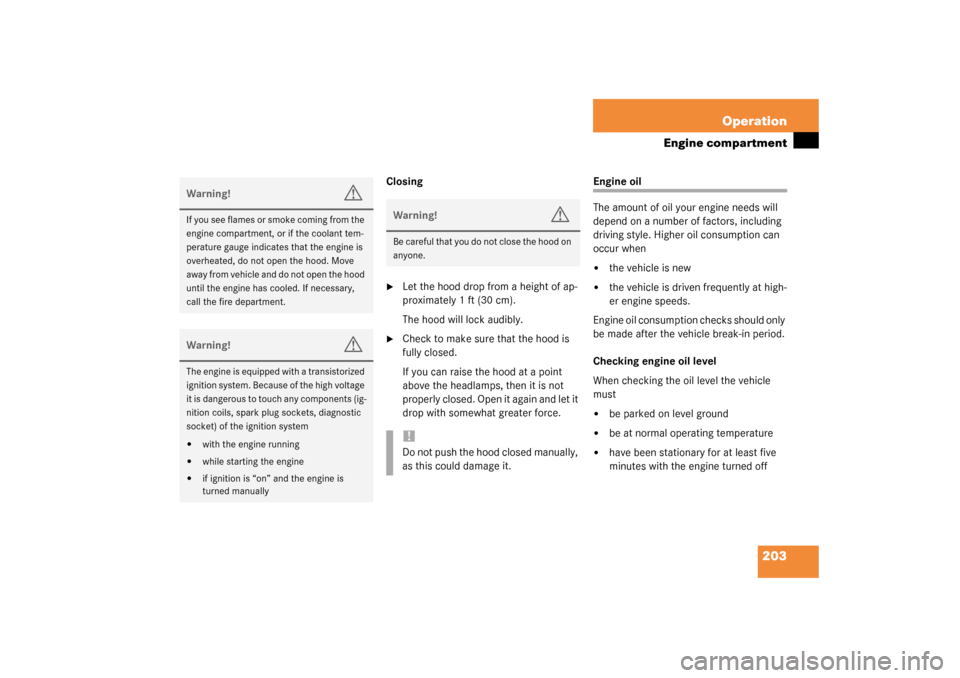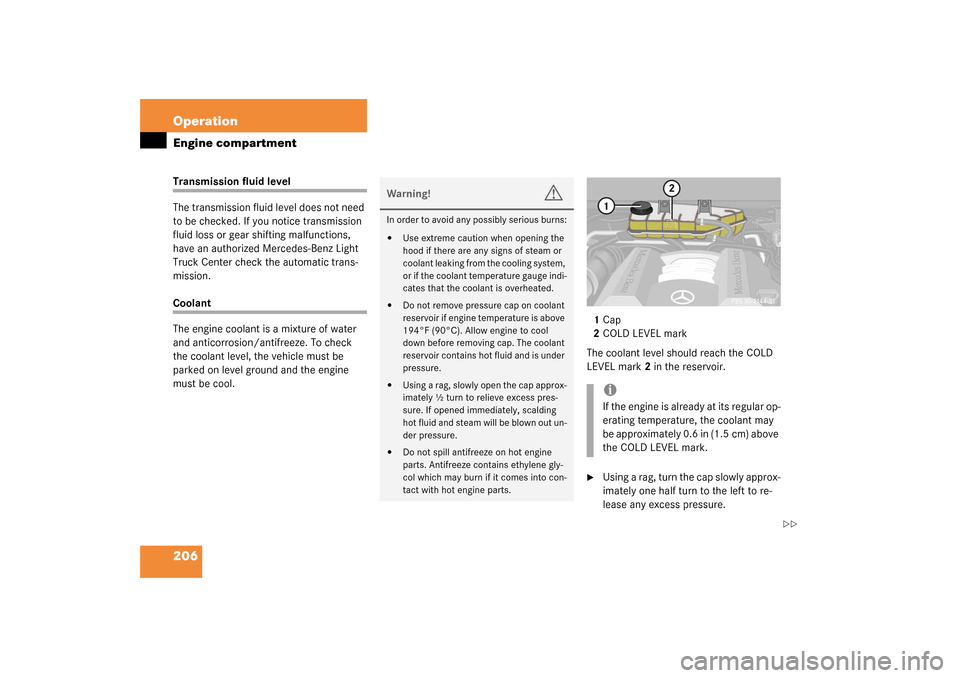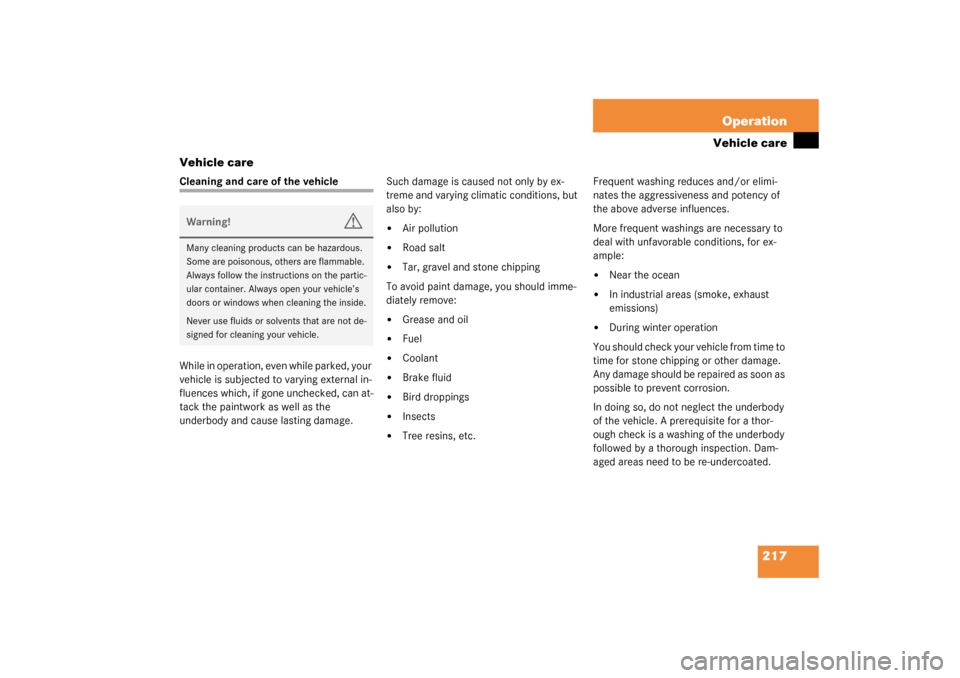Page 199 of 321
199 Operation
Driving instructions
Coolant temperature
During severe operating conditions and
stop-and-go city traffic, the coolant tem-
perature may rise to approx. 248°F
(120°C).
The engine should not be operated with
the coolant temperature in the red zone.
Doing so may cause serious engine dam-
age which is not covered by the
Mercedes-Benz Limited Warranty.
Warning!
G
�
Driving when your engine is badly over-
heated can cause some fluids which
may have leaked into the engine com-
partment to catch fire. You could be se-
riously burned
�
Steam from an overheated engine can
cause serious burns and can occur just
by opening the engine hood. Stay away
from the engine if you see or hear steam
coming from it.
Turn off the engine, get out of the vehicle
and do not stand near the vehicle until it
cools down.
Page 201 of 321

201 Operation
At the gas station
Check regularly and before a long trip�
Open the hood (
�page 202)
1Engine oil level
More information on engine oil can be
found in the “Operation” section
(
�page 203).
2Coolant level
For normal replenishing, use water (po-
table water quality). More information
on the coolant level can be found in the
“Operation” section (
�page 206).
3Brake fluid
More information on brake fluid can be
found in the “Technical data” section
(
�page 284).4Windshield washer and headlamp
cleaning system
More information on filling the reser-
voir can be found in the “Operation”
section (
�page 208).
Vehicle lighting
Check function and cleanliness. More in-
formation on replacing light bulbs can be
found in the “Practical hints” section
(
�page 247).
Combination switch (
�page 102).
Tire inflation pressure
More information on tire inflation pressure
can be found in the “Operation” section
(
�page 211).
iLeaving the engine running and the fuel
cap open can cause the
?
lamp to
illuminate.
See also “Practical hints” section
(
�page 232).
Page 203 of 321

203 Operation
Engine compartment
Closing�
Let the hood drop from a height of ap-
proximately 1ft (30cm).
The hood will lock audibly.
�
Check to make sure that the hood is
fully closed.
If you can raise the hood at a point
above the headlamps, then it is not
properly closed. Open it again and let it
drop with somewhat greater force.
Engine oil
The amount of oil your engine needs will
depend on a number of factors, including
driving style. Higher oil consumption can
occur when �
the vehicle is new
�
the vehicle is driven frequently at high-
er engine speeds.
Engine oil consumption checks should only
be made after the vehicle break-in period.
Checking engine oil level
When checking the oil level the vehicle
must
�
be parked on level ground
�
be at normal operating temperature
�
have been stationary for at least five
minutes with the engine turned off
Warning!
G
If you see flames or smoke coming from the
engine compartment, or if the coolant tem-
perature gauge indicates that the engine is
overheated, do not open the hood. Move
away from vehicle and do not open the hood
until the engine has cooled. If necessary,
call the fire department.Warning!
G
The engine is equipped with a transistorized
ignition system. Because of the high voltage
it is dangerous to touch any components (ig-
nition coils, spark plug sockets, diagnostic
socket) of the ignition system�
with the engine running
�
while starting the engine
�
if ignition is “on” and the engine is
turned manually
Warning!
G
Be careful that you do not close the hood on
anyone.!Do not push the hood closed manually,
as this could damage it.
Page 206 of 321

206 OperationEngine compartmentTransmission fluid level
The transmission fluid level does not need
to be checked. If you notice transmission
fluid loss or gear shifting malfunctions,
have an authorized Mercedes-Benz Light
Truck Center check the automatic trans-
mission.Coolant
The engine coolant is a mixture of water
and anticorrosion/antifreeze. To check
the coolant level, the vehicle must be
parked on level ground and the engine
must be cool. 1Cap
2COLD LEVEL mark
The coolant level should reach the COLD
LEVEL mark2 in the reservoir.
�
Using a rag, turn the cap slowly approx-
imately one half turn to the left to re-
lease any excess pressure.
Warning!
G
In order to avoid any possibly serious burns:�
Use extreme caution when opening the
hood if there are any signs of steam or
coolant leaking from the cooling system,
or if the coolant temperature gauge indi-
cates that the coolant is overheated.
�
Do not remove pressure cap on coolant
reservoir if engine temperature is above
194°F (90°C). Allow engine to cool
down before removing cap. The coolant
reservoir contains hot fluid and is under
pressure.
�
Using a rag, slowly open the cap approx-
imately ½ turn to relieve excess pres-
sure. If opened immediately, scalding
hot fluid and steam will be blown out un-
der pressure.
�
Do not spill antifreeze on hot engine
parts. Antifreeze contains ethylene gly-
col which may burn if it comes into con-
tact with hot engine parts.
iIf the engine is already at its regular op-
erating temperature, the coolant may
be approximately 0.6 in (1.5 cm) above
the COLD LEVEL mark.
��
Page 207 of 321

207 Operation
Engine compartment
�
Continue turning the cap to the left and
remove it.
�
Add coolant as required.
�
Replace and tighten cap.
More information on coolant can be found
in the “Technical data” section
(
�page 287).
Battery
The battery is located in the engine com-
partment.
The battery should always be sufficiently
charged in order to achieve its rated ser-
vice life.
If you use your vehicle mostly for short dis-
tance trips, you will need to have the bat-
tery charge checked more frequently.
When replacing batteries, always use bat-
teries approved by Mercedes-Benz.If you do not intend to operate your vehicle
for an extended period of time, consult an
authorized Mercedes-Benz Light Truck
Center about steps you need to observe.
Batteries contain materials that can harm
the environment if disposed of improperly.
Recycling of batteries is the preferred
method of disposal. Many states require
sellers of batteries to accept old batteries
for recycling.
G
Observe all safety instructions
and precautions when handling
automotive batteries.
A
Risk of explosion
D
Keep flames or sparks away
from battery. Do not smoke.
B
Battery acid is caustic. Do not
allow it to come into contact
with skin, eyes or clothing.
In case it does, immediately
flush affected area with clear
water and seek medical help if
necessary.
E
Wear eye protection.
C
Keep children away.
F
Follow the instructions in this
Operator's Manual.
Page 217 of 321

217 Operation
Vehicle care
Vehicle care
Cleaning and care of the vehicle
While in operation, even while parked, your
vehicle is subjected to varying external in-
fluences which, if gone unchecked, can at-
tack the paintwork as well as the
underbody and cause lasting damage.Such damage is caused not only by ex-
treme and varying climatic conditions, but
also by:
�
Air pollution
�
Road salt
�
Tar, gravel and stone chipping
To avoid paint damage, you should imme-
diately remove:
�
Grease and oil
�
Fuel
�
Coolant
�
Brake fluid
�
Bird droppings
�
Insects
�
Tree resins, etc.Frequent washing reduces and/or elimi-
nates the aggressiveness and potency of
the above adverse influences.
More frequent washings are necessary to
deal with unfavorable conditions, for ex-
ample:
�
Near the ocean
�
In industrial areas (smoke, exhaust
emissions)
�
During winter operation
You should check your vehicle from time to
time for stone chipping or other damage.
A n y d a m a g e s h o u l d b e r e p a i r e d a s s o o n a s
possible to prevent corrosion.
In doing so, do not neglect the underbody
of the vehicle. A prerequisite for a thor-
ough check is a washing of the underbody
followed by a thorough inspection. Dam-
aged areas need to be re-undercoated.
Warning!
G
Many cleaning products can be hazardous.
Some are poisonous, others are flammable.
Always follow the instructions on the partic-
ular container. Always open your vehicle’s
doors or windows when cleaning the inside.
Never use fluids or solvents that are not de-
signed for cleaning your vehicle.
Page 230 of 321

230 Practical hintsWhat to do if …Problem
Possible cause
Suggested solution
/
The yellow coolant warning lamp
lights up when the engine is run-
ning.
The coolant is to hot.
The coolant level is too low.
�
Stop as soon as possible and allow
the engine and coolant to cool down.
�
Check the coolant level and add
coolant if necessary (
�page 206).
If the warning lamp lights up frequently, there
is a leak in the cooling system.
�
Have the cooling system checked by
an authorized Mercedes-Benz Light
Truck Center.
The coolant temperature gauge is above
248 °F (120 °C).
The coolant level is too low.
�
Stop as soon as possible and allow
the engine and coolant to cool down.
�
Add coolant to prevent engine from
overheating (
�page 206).
If the coolant level is correct, the electrical
radiator fan may be broken.
�
If the coolant temperature is below
the red zone, drive on to the nearest
authorized Mercedes-Benz Light
Truck Center.
Avoid high engine loads (e.g. driving
uphill) and stop-and-go driving.
Page 231 of 321
231 Practical hints
What to do if …
Warning!
G
Driving when your engine is badly overheat-
ed can cause some fluids which may have
leaked into the engine compartment to
catch fire. You could be seriously burned.
Steam from an overheated engine can cause
serious burns and can occur just by opening
the engine hood. Stay away from the engine
if you see or hear steam coming from it.
Turn off the engine, get out of the vehicle
and do not stand near the vehicle until it
cools down.Warning!
G
Do not spill antifreeze on hot engine parts.
Antifreeze contains ethylene glycol which
may burn if it comes into contact with hot
engine parts. You can be seriously burned.
!Do not ignore the coolant warning
lamps. Extended driving with the sym-
bol displayed may cause serious engine
damage not covered by the
Mercedes-Benz Limited Warranty.
Do not drive without sufficient amount
of coolant. The engine will overheat,
causing major engine damage.